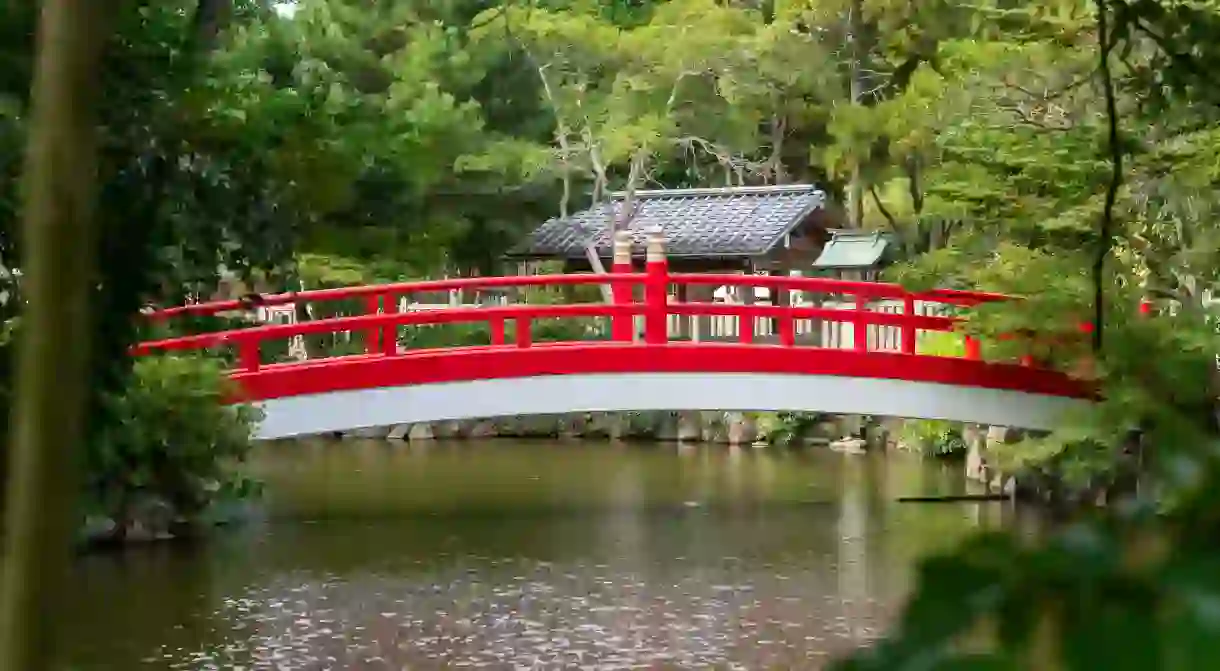Two Days in Hyogo's Historic Harima and Awaji Regions

Paid partnership with

When people think of Hyogo, two things jump to mind: Kobe beef, and the majestic Himeji Castle, also known as “White Heron Castle”. Though it’s a short journey from busy Osaka and Kyoto – just one to two hours’ by car or shinkansen – Hyogo is often left off people’s itineraries entirely. But there’s so much to discover for people who love traditional Japanese culture and history.
In the southwest of Hyogo lies Harima, a region where traditional crafts still thrive in its inland areas. Further south across the sea is Awaji Island, which holds cultural significance as both Japan’s mythological birthplace and the historical heart of the nation’s incense industry. This two-day itinerary will take you deep into the heart of traditional Japan, where master craftsmen still practice centuries-old arts and sacred sites unveil the mythical stories of Japan’s birth.
Day 1: Visit an ancient forge and soak in Shiota Onsen
Your first stop is the Kikyo Hayamitsu Japanese Sword Smithy in Harima, around 20 minutes from Himeji City by train, where the ancient art of Japanese sword-making continues to thrive. The forge is set in a beautiful Japanese garden, complete with koi pond and carefully placed rocks, providing a serene backdrop to balance the smolderingly intense craftwork.
Here, you can meet a master swordsmith who will demonstrate the mesmerizing process of forging traditional Japanese blades, as wielded by samurai. A rare type of Japanese charcoal is used, which allows the forge to reach an intense heat as the rhythmic bellows and striking of metal transforms raw steel into blades. Under the instructor’s patient guidance, visitors craft their knives using specialized techniques and traditional equipment. It’s an unforgettable experience where you feel the weight of history in every strike.

After experiencing the hard work of a smithy, make your way to the therapeutic waters of Shiota Onsen. This historic Edo period (1600~1868) hot spring, nestled in the mountains along the Yumesaki River, has been soothing travelers for centuries with its chloride spring waters. The spring’s exceptional water quality made it famous throughout Japan. As night falls, try seasonal delicacies in the area; many traditional inns serve freshwater fish from the river, wild plants and prized matsutake mushrooms, amongst other Japanese delicacies. After the healing waters and mountain cuisine have restored your spirit, settle into your traditional ryokan for the night.

Day 2: Explore the sacred traditions and crafts of Awaji Island
Begin your second day at Awaji Baikundou, on Awaji Island, a fragrance factory that has been crafting incense and other aromatic products since 1905. Awaji is the center of Japan’s incense industry, which dates back to 595 AD. Islanders lit incense wood that had been washed ashore on Awaji Island, and the fragrance was so wonderful that it was presented to the Imperial Court. It’s also home to the only kōshi, or aroma master, in Japan. At Awaji Baikundou, you’ll learn the delicate art of creating incense, carefully blending naturally fragrant ingredients with sandalwood powder or aloeswood powder to create your own unique blend. The incense-making process is precise, and you can create your own unique fragrance by blending sandalwood powder with other aromatic ingredients. After having a go yourself, you’ll also be able to watch skilled artisans at work in the factory, witnessing techniques passed down through generations. This is also a perfect place to pick up souvenirs, with a selection of unique gift sets available.

Next is Izanagi Shrine, Japan’s oldest Shinto shrine dedicated to the gods Izanagi and Izanami, founders of Japan. After entering through the Torii gate, the shrine grounds invite peaceful exploration as you follow the path across the pond over an iconic red bridge. The shrine’s centerpiece is a majestic camphor tree that dates back around 900 years and has witnessed countless prayers and ceremonies throughout the centuries. Beyond the main shrine, you’ll discover smaller shrines dedicated to agriculture, longevity, sake brewing, and disaster protection.

Cap your journey on a scenic Nushima Onokoro cruise, which takes you around the beautiful landscape of Nushima Island. Local fishermen have a special relationship with these waters, circling certain rock formations as gestures of gratitude and good fortune.
The trip takes you up close to the legendary Tategami rock, believed to be where the gods Izanagi and Izanami created the first islands of the Japanese archipelago. Your guide (speaking in basic English) will share ancient stories of Japan’s birth as you see the unique rock formations and hidden caves that can only be seen by boat. The changing colors and patterns of the rocky coastline create natural artwork that seems to reach toward the heavens.
This journey through Hyogo reveals a stunning landscape and a Japan that many visitors never see. Here, ancient crafts still flourish, sacred traditions remain alive, and the mythological birthplace of a nation can still be witnessed. Each experience offers a glimpse of history and a chance to participate in living traditions that have shaped Japanese culture for centuries.

Timing: Awaji Baikundou is open 9am-12pm and 1pm-4pm (closed 2nd and 4th Saturdays/Sundays/Holidays). The Nushima Onokoro cruise operates 9am-5pm (closed Tuesdays and Fridays, with early closure at 12.30pm on Wednesdays and Thursdays). Advance booking is recommended for all experiences.
Transport: From Kyoto Station, the Shinkansen takes just 28 minutes to Himeji Station in western Hyogo, while from Shin-Osaka Station it’s a quick 44-minute ride. By car, central Hyogo is accessible via the Chugoku Expressway or Meishin Expressway, with the journey taking approximately 1-2 hours from either Osaka or Kyoto.












